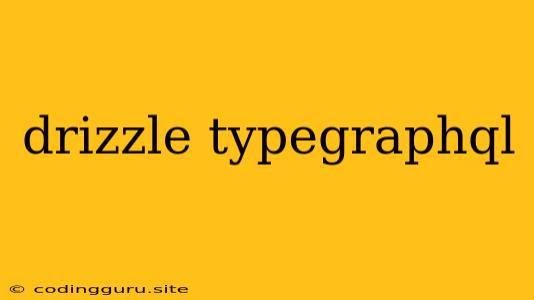Drizzle and TypeGraphQL: A Powerful Combination for Building GraphQL APIs
Building GraphQL APIs can be a complex task, but with the right tools, it can be made much easier. Two popular tools for this purpose are Drizzle and TypeGraphQL.
Drizzle is a powerful ORM (Object-Relational Mapping) for Node.js that simplifies database interactions. It leverages TypeScript for type safety and provides a clean and intuitive API for working with databases.
TypeGraphQL is a library that allows you to define your GraphQL schema using TypeScript classes. It uses decorators to define fields, arguments, and resolvers, making it easy to map your data model to your GraphQL schema.
This article will explore how you can combine Drizzle and TypeGraphQL to create robust and efficient GraphQL APIs.
Why Choose Drizzle and TypeGraphQL?
There are several reasons why Drizzle and TypeGraphQL are a great choice for building GraphQL APIs:
- Type Safety: Both Drizzle and TypeGraphQL are built with TypeScript, ensuring type safety throughout your codebase. This helps you catch errors early and ensures that your code is reliable.
- Productivity: Drizzle's powerful ORM and TypeGraphQL's decorators simplify the development process, allowing you to focus on your business logic.
- Scalability: Both libraries are designed for scalability, making them suitable for projects of all sizes.
- Community Support: Both Drizzle and TypeGraphQL have active communities, providing ample resources and support for developers.
Setting Up Your Project
-
Install the required dependencies:
npm install drizzle-orm typegraphql @types/node @types/express @types/cors -
Create your Drizzle configuration:
import { drizzle } from "drizzle-orm"; import { postgres } from "drizzle-orm/postgres"; import { db } from "./db"; const drizzleConfig = drizzle(postgres, db); -
Define your data models:
import { pgTable, varchar, integer } from "drizzle-orm/postgres"; export const users = pgTable("users", { id: varchar("id", { length: 255 }).primaryKey(), name: varchar("name", { length: 255 }), age: integer("age"), }); -
Create your TypeGraphQL resolvers:
import { Resolver, Query, Arg } from "typegraphql"; import { User } from "./models"; import { drizzleConfig } from "./drizzleConfig"; @Resolver(of => User) export class UserResolver { @Query(returns => User) async getUser(@Arg("id") id: string) { return drizzleConfig.select().from(users).where(users.id.equals(id)).get(); } }
Basic Example
Let's create a simple example to illustrate how to use Drizzle and TypeGraphQL to build a GraphQL API.
Scenario: We want to create an API to manage users. Each user has a unique ID, name, and age.
Data Model:
import { pgTable, varchar, integer } from "drizzle-orm/postgres";
export const users = pgTable("users", {
id: varchar("id", { length: 255 }).primaryKey(),
name: varchar("name", { length: 255 }),
age: integer("age"),
});
Resolvers:
import { Resolver, Query, Arg, Mutation } from "typegraphql";
import { User } from "./models";
import { drizzleConfig } from "./drizzleConfig";
@Resolver(of => User)
export class UserResolver {
@Query(returns => User)
async getUser(@Arg("id") id: string) {
return drizzleConfig.select().from(users).where(users.id.equals(id)).get();
}
@Mutation(returns => User)
async createUser(
@Arg("name") name: string,
@Arg("age") age: number,
) {
const newUser = await drizzleConfig.insert(users).values({
id: '123', // or generate a new uuid
name,
age,
}).returning();
return newUser;
}
}
Schema:
type User {
id: String!
name: String!
age: Int!
}
type Query {
getUser(id: String!): User
}
type Mutation {
createUser(name: String!, age: Int!): User
}
Explanation:
- Data Model: The
userstable defines the schema for our user data. - Resolvers:
- The
getUserresolver retrieves a user by their ID. - The
createUserresolver inserts a new user into the database.
- The
- Schema: The GraphQL schema defines the types and operations available in our API.
Handling Relationships
Drizzle and TypeGraphQL make it easy to manage relationships between your data models. You can use the relation function from Drizzle to define relationships between tables. TypeGraphQL provides decorators to map these relationships to your GraphQL schema.
Example: Let's say we have a posts table that has a foreign key relationship with the users table.
Data Model:
import { pgTable, varchar, integer, relation } from "drizzle-orm/postgres";
export const posts = pgTable("posts", {
id: varchar("id", { length: 255 }).primaryKey(),
title: varchar("title", { length: 255 }),
userId: varchar("userId", { length: 255 }),
user: relation("user", () => users),
});
Resolvers:
import { Resolver, Query, Arg } from "typegraphql";
import { Post } from "./models";
import { drizzleConfig } from "./drizzleConfig";
@Resolver(of => Post)
export class PostResolver {
@Query(returns => [Post])
async getPosts() {
return drizzleConfig.select().from(posts).all();
}
}
Schema:
type Post {
id: String!
title: String!
user: User!
}
type Query {
getPosts: [Post]
}
Advanced Features
Drizzle and TypeGraphQL offer a wide range of advanced features:
- Pagination: Easily implement pagination to handle large datasets.
- Filtering and Sorting: Define filters and sorting options for your queries.
- Authorization and Authentication: Secure your API using middleware and decorators.
- Caching: Improve performance by implementing caching for your resolvers.
- Mutations: Create and update data using mutations.
Troubleshooting Common Issues
Here are some common issues you might encounter while working with Drizzle and TypeGraphQL and how to troubleshoot them:
- Type Mismatches: Ensure that your data models and resolvers use the correct types. TypeScript's type system will help catch these errors.
- Database Errors: If you encounter database errors, review your Drizzle configuration and SQL queries for any mistakes.
- GraphQL Errors: If you see GraphQL errors, check your schema definition, resolver logic, and argument types.
Conclusion
Drizzle and TypeGraphQL provide a powerful and efficient combination for building GraphQL APIs. Their type safety, productivity features, and community support make them ideal for developers of all skill levels. By leveraging the features of these libraries, you can create robust and scalable GraphQL APIs that meet the needs of your applications.
